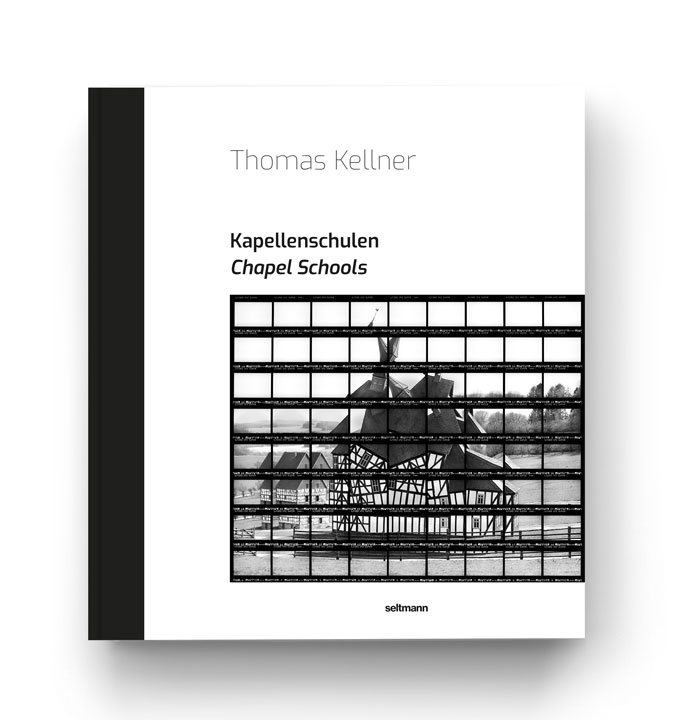Chapel Schools a solitary architectural type
Chapel schools form a solitary architectural type for the Siegerland and its neighboring regions. As stand-alone buildings and conspicuous in their surroundings, they reveal the connection between religion and school education starting from the domain of Count William I of Nassau-Katzenelnbogen (1487-1559) and his son John VI of Nassau, Katzenelnbogen and Dietz (1536-1606). The hybrid used buildings existed until the end of the 19th century and in parts even until the 20th century.
The Siegen fine art photographer Thomas Kellner recognized the historical and cultural value of these buildings and set himself the task of preserving and recalling this typical regional cultural asset through a new medium. By means of photography he transfers the chapel schools into an artistic context and gives the historical topic a new dimension in the present (art).
Just as the chapel schools united in themselves two spheres of life, this publication also conveys different contemporary perspectives on the history and genesis of the chapel schools. While Kellner tries to rethink the type of building, which oscillates between profane and sacred, with his artistic realization, Chiara Manon Bohn, Isabell Eberling M. Sc. Dr. Andrea Gnam and Dr. Stefanie Siedek-Strunk provide an insight into the historical, architectural and religious classification of the chapel schools up to the pictures of Thomas Kellner in text contributions.
The Chapel Schools' Book

Detailed information about the chapel schools' book
| Title: | Thomas Kellner – Chapel Schools. In the footsteps of the Nassau Counts William I and John VI |
| Editor: | Oliver Seltmann |
| Authors: | Thomas Kellner, Chiara Manon Bohn, Isabell Eberling M.Sc., Dr. Andrea Gnam, Dr. Stefanie Siedek-Strunk |
| Photographer: | Thomas Kellner |
| Content: | 208 pages, 53 plates and 49 illustrations |
| Size: | 24,5 x 30,5 cm, Hardcover, Half-linen |
| Language(s): | German, English |
| Publisher: | Seltmann Publishers |
| Edition: | 500 |
| ISBN: | 978-3-949070-30-3 |
| Release Date: | 19 December, 2022 |
| Price: | 48 Euros |
In case you want to know more about these unique chapel schools join the newsletter!
Acknowledgement for this book of the chapel schools
This book is above all a tribute to Siegen and the Siegerland in Germany — my home by choice. This project would not have been possible without the support of the following individuals and organizations:
First, I would like to thank Chiara Manon Bohn, Isabell Eberling, Andrea Gnam, and Stefanie Siedek-Strunk for their expert essays on the chapel schools. Special appreciation is extended to my wife, Helga Kellner, and her Artgalerie Siegen for hosting the exhibition.
Next, my gratitude goes to the Siegen City Archive that represents all the historical landmark offices in the region for their aid. Especially noteworthy is Thomas Wolf at the County Archive, Siegen-Wittgenstein County (Archiv des Kreises Siegen-Wittgenstein) for initiating this body of work, supported by a grant from the Ministry of Culture and Sciences, State of North Rhine-
Westphalia, (Ministerium für Kultur und Wissenschaft des Landes Nordrhein-Westfalen), particularly at the beginning of the research.
I am also grateful for the Neustart Kultur [Re-Start Culture] grant to translate this research into images awarded by the German Federal
Government Commissioner for Culture and the Media (Beauftragte der Bundesregierung für
Kultur und Medien) through the German Cultural Foundation for Images and Art (Stiftung Kulturwerk der VG Bild-Kunst). The final production of the analog images starting with the scans and prints up to the exhibition including a catalog would not have been possible without donations from Siegen-Wittgenstein County, the city of
Siegen, the municipality of Neunkirchen, BGH Edelstahlwerke GmbH, VETTER Industrie GmbH, EJOT Holding GmbH & Co KG, and Dr. Hubertus Koch.
On behalf of the many interns in my studio, I would like to thank Chiara Manon Bohn for her valuable collaboration on this book project, Janinë Spahiu for her work on the chapel school descriptions, and Andreas Fischer for his support in photo editing.
Then, we would like to thank Nelly Thomas for her competent translation into English and Julia Montanus for her meticulous review and proof-reading.
Once the content has been mastered, a book requires a proper format. Peter Büdenbender, our graphic designer, has definitely presented this body of work in a stylistically appropriate format.
Finally, I greatly appreciate Arno Seltmann for the fabulous printing of this book and Oliver Seltmann for publishing this book at Seltmann Publishers.








